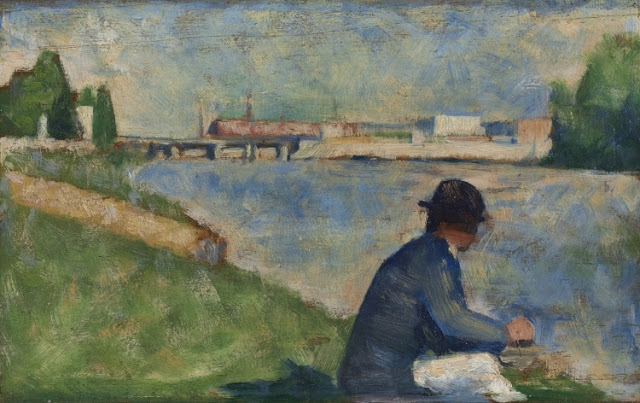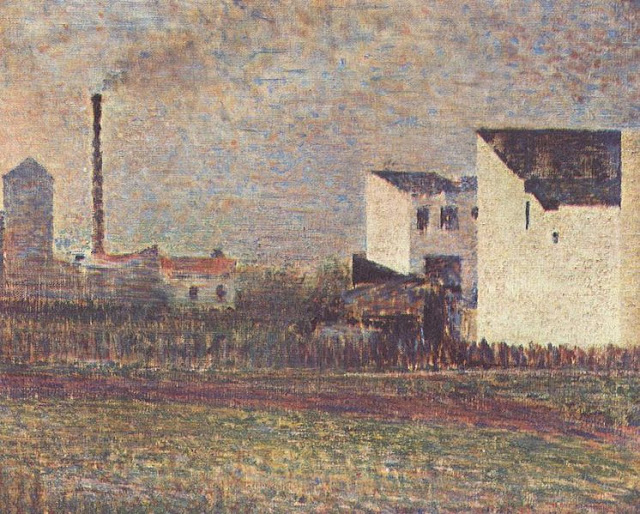 |
| Georges Seurat by Ernest Laurent Seurat 1883 |
 |
| 1883 Fishermen 16.2 x 24.8 cm |
 |
| 1883 Route de Gennevilliers |
 |
| c1883-4 Poplars conté crayon on paper 24.3 x 31 cm |
 |
| c1883-4 Stone Breaker with Wheelbarrow oil on panel 17.1 x 26 cm |
 |
| c1883 Boat by the Bank, Asnieres oil on canvas 15 x 24 cm © The Samuel Courtauld Trust, The Courtauld Gallery, London |
 |
| c1883 House Among the Trees oil on panel 16 x 25 cm |
 |
| c1883 Man Painting his Boat oil on panel 16 x 24 cm |
 |
| c1883 Two Banks oil on panel 15 x 24.8 cm |
 |
| 1884 Bathers at Asnières oil on canvas 201 x 300 cm |
 |
| 1883 Seated Nude, Study for Bathers at Asnières conté crayon on paper 31.7 x 24.7 cm |
 |
| 1883-4 L'Echo, study for Bathers at Asnières conté crayon on Michallet paper 31.2 x 24 cm |
 |
| c1883-4 Study for Bathers at Asnières oil on wood 15.7 x 24.9 cm |
 |
| 1884-86 Sunday Afternoon on the Island of la Grande Jatte oil on canvas 207.5 x 308.1 |
 |
| 1884 A Woman Fishing ( study for la Grande Jatte ) conté crayon on paper 30.8 x 23.8 cm |
 |
| 1884 Monkey ( study for la Grande Jatte ) conté crayon on paper 31.1 x 23.9 cm |
 |
| 1884 Oil Sketch for la Grande Jatte oil on panel 15.5 x 24.3 cm |
 |
| 1884 Study for la Grande Jatte oil on canvas 70.5 x 104.1 cm |
 |
| 1884 Study for la Grande Jatte oil on wood 15.6 x 24.1 cm |
 |
| 1884 Study for la Grande Jatte |
+conte%CC%81+crayon+on+laid+paper+47.4+x+61.5+cm.jpg) |
| 1884 Tree Trunks ( study for la Grande Jatte ) conté crayon on laid paper 47.4 x 61.5 cm |
+conte%CC%81+crayon+on+laid+paper+62+x+47.5+cm.jpg) |
| 1884 Trees ( study for la Grande Jatte ) conté crayon on laid paper 62 x 47.5 cm |
+conte%CC%81+crayon+on+laid+paper+31.7+x+24.1+cm.jpg) |
| 1884 Woman Walking with a Parasol ( study for la Grande Jatte ) conté crayon on laid paper 31.7 x 24.1 cm |
 |
| 1884 Woman with a Parasol ( study for la Grande Jatte ) |
+conte%CC%81+crayon+on+laid+paper+47.7+x+31.5+cm.jpg) |
| 1884-5 Seated Woman with a Parasol ( study for la Grande Jatte ) conté crayon on laid paper 47.7 x 31.5 cm |
 |
| 1884-5 Study for la Grande Jatte oil on panel 15.6 x 25.2 cm |
 |
| c1884-6 Woman with Umbrella conté crayon on Michallet paper 31.7 x 24.7 cm |
 |
| c1884 Fisherman oil on panel 33.5 x 42.7 cm |
 |
| c1884 Man in a Boat oil on panel 15 x 24 cm © The Samuel Courtauld Trust, The Courtauld Gallery, London |
 |
| c1884 The Rue St. Vincent, Paris, in Spring oil on panel 24.7 x 15.5 cm |


.jpg)













+conte%CC%81+crayon+on+Michallet+paper+62.2+x+47.5+cm.jpg)









+oil+on+canvas+34.3+x+42+cm.jpg)


